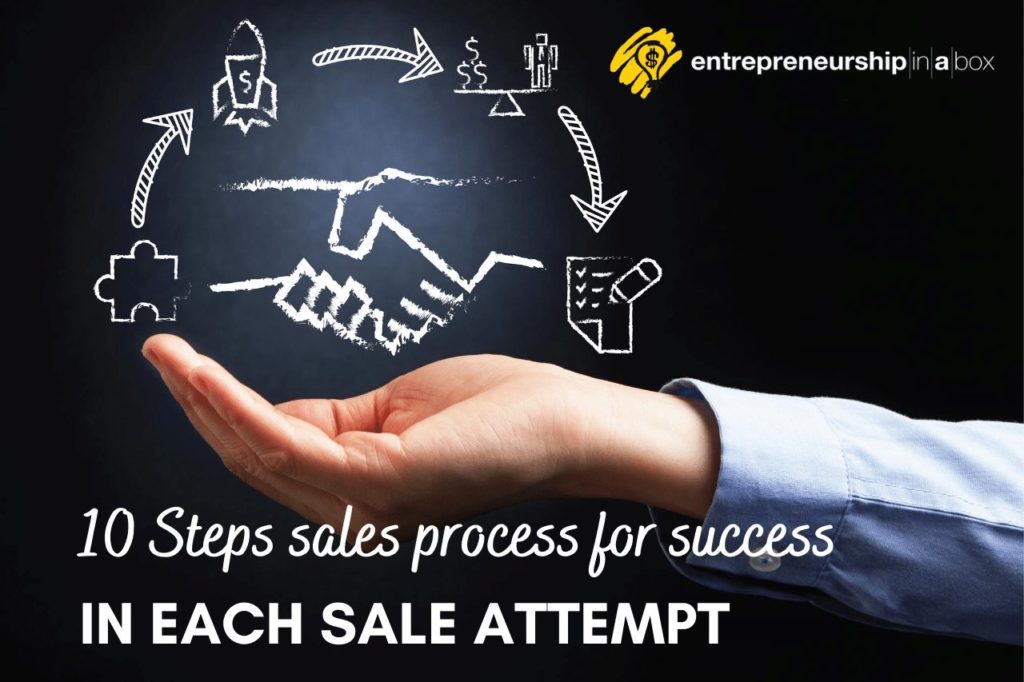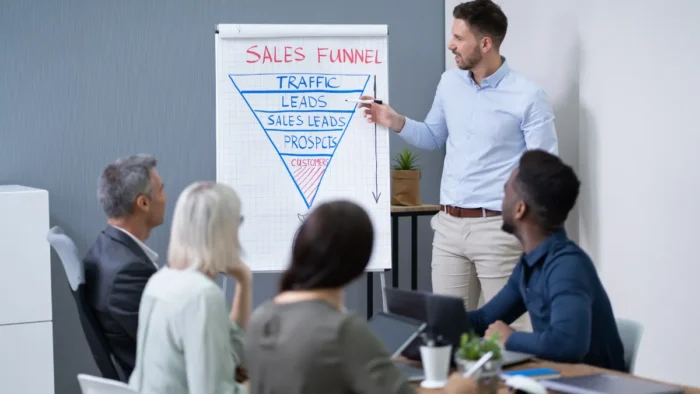Do you try to sell something, and you don’t successfully convince the potential customer to make a buying decision? How much is the success rate of your sales process?
Let’s say you have 100 attempts to sell something to your customers, and only 15 of them make a buying decision. In that case, the success rate of your sales process is 15%.
Trying to close the sales and closing sales are different things due to your sales process.
Also, the number of closed sales and the number of repeated sales are different things as a result of your sales process.
There is no such thing as an easy sale. The trick is to use the proper sales process to bring in more sales and retain more customers.
Remember that sales are not a one-shot deal. If you want to achieve consistent sales results, you must be prepared to take on more than just one sales step at a time. Here is a proven sales process for getting you to consistently close more sales.
Sales Process Achievements
What would you like to achieve with your sales process?
The logical sequence that entrepreneurs commonly use for their sales process is the following:
- Try to sell something,
- failure or success and
- repeat the sales process if they succeed in the previous step.
In such a process, if you have a success rate of 10% from trying to sell to a closed sale, with ten attempts, you will realize one sale. Therefore, entrepreneurs logically try to find ways to increase their potential customers to increase closed sales. So, if instead of 10 attempts, you make 20 attempts, you will generate two sales, and so on.
However, time and resources will not allow you to increase such efforts to infinity. On the other hand, all your unsuccessful attempts will be lost for a longer time in the future.
What would be if all of your sales process attempts you can convert into successful sales? It is a goal that you should try to achieve.
Because of that, here I will present ten steps that can help you to increase your success rate for each sales attempt you make.
1. Prospecting
You must collect enough data for the potential customers you want to contact as a part of your sales process.
Prospecting simply means identifying and qualifying prospects or potential customers most likely to be interested in your products or services. Do not start trying to sell something to someone without having enough information about them. Yes, your sales process will need to start with the right information.
What approach will you apply? How will you start? Where will you attempt to sell? What will you talk to your potential customers about? What will you need to listen to them?
All of these questions are something that you need to answer before you start. Today, it is easy to get complete knowledge about potential customers.
Here are the steps you need to take for prospecting:
Define your target market and research potential customers.
In this step, you will need to identify the problems, needs, requirements, pain points, and demographics of your target market. Use different data sources for your research. The output of this step will be the list of potential customers you want to contact and attempt to offer them your products and services.
The Prioritize your list of identified potential customers.
The second step is to prioritize the list of prospects based on their probability of buying, how much they are ready to spend, and their potential value as a customer for your small business.
Reach out to your potential customers.
Now is the right time to reach out to your potential customers. You can use various methods, such as phone calls, email, or social media, to reach out and introduce yourself and your company. You need to use your first reach to your potential customers as a potential to learn more about them and appropriately qualify them. Simply, you want to find if an identified potential customer is a good fit for your products or services and if they are ready to purchase.
Update your list continuously.
For a successful sales process, you will always need an updated list of potential customers ready to be contacted. So, make sure that you continuously update your list of potential customers by adding new leads and removing those who are still not ready to make a purchase.
✋ Warning
Follow this ultimate step-by-step guide to find customers with the right purchase intent. Remember that if you focus all your attempts on the customers with the right purchase intent, you will drastically improve your sales success rate. This means that your sales process will become more productive process.
2. Problems, needs, and frustrations.
Dig deeper into your customer’s problems, needs, and frustrations.
Related: Find Your Rhythm: How Inspirational Music Increases Productivity at Work
All the information that you collect will need to transfer into the right group of major problems, needs, and frustrations of the potential customer.
However, you want to solve a real problem. You want to meet an existing need, and normally you want to help them overcome their frustration.
By digging deeper into your customer’s problems, needs, and frustrations, you can easily learn more about your potential customers. You will understand how your products can provide the right value to them. Also, you can also use this knowledge to create a more personalized and effective sales pitch.
Here are three important steps to help you dig deeper into a customer’s problems, needs, and frustrations:
Regular communication with potential customers.
Try to build regular communication with potential customers after you make first reach out to them. You can ask open-ended questions to encourage them to share more about their problems, needs, and frustrations. For example, ask questions like:
- Can you tell me more about the challenges you’re facing?
- What are your biggest problems and needs?
- What makes you feel frustrated?
- What are your goals?
- How does this specific problem (that you are solving with your products and services) affect your life?
Create a listening process to listen to your potential customers.
You need to listen to them and pay attention to their nonverbal behavior because they will not always be totally honest with you when you are asking such personal questions.
You need to be empathetic toward their problems and frustrations. Simply, you want to build trust and connection with them by encouraging them to share more information with you.
Record all important findings you get from your potential customers.
Be careful and take notes during the conversation with your potential customer. This is important because you want to record everything related to them inside your CRM tool.
3. Emotional triggers
Find all possible emotional triggers that will encourage them to make a positive decision at the end of your sales process.
Everyone has emotions, and all those emotions have a meaningful impact on your decisions in a certain period of time.
It is good to try to discover as many emotional triggers as possible that you will simply use in the further sales process. They will give you extra power to succeed when selling to a potential customer.
There are certain words and phrases that evoke an emotional response in the customer, making them more likely to take action. Emotions can be used to influence a customer’s buying decision in sales.
Here are some examples of emotional triggers you can use in your sales process:
Scarcity is an emotional trigger in the sales process.
A product or service is scarce when there are only a certain number of units available, and no more will ever be made. Customers love things that are scarce because it makes them feel unique. It also creates a feeling of wanting something scarce because it means that we don’t want someone else to have it.
Creating a sense of urgency by emphasizing limited availability or time-sensitive offers can trigger a sense of scarcity, making customers more likely to buy.
Fear as an emotional trigger.
Fear is a very powerful motivational factor. It affects our opinions and behaviors more than any other emotion. So the first thing you need to understand is why people feel fear. One reason why fear can be so powerful is that it taps into emotions that run deep within us. Another reason is that fear is a signal that something is wrong.
Frustration.
Frustration happens when a person faces obstacles or barriers to solving a specific problem. For example, if your prospect is feeling frustrated, you could offer to help him to fix the problem. Remember that people who feel frustrated often turn to find quick-fix solutions for their problems.
Regret.
Many people are prone to making poor choices. This often leads to them feeling regret and needing to take action to reverse a bad decision. Research shows that people who feel regret are more likely to buy a product than people who don’t. It is because regret makes us feel guilty. On the other side, guilty makes us think about whether we’ll feel regret if we pass up this opportunity to buy.
Excitement.
One of the most effective ways to sell something is to help someone realize they want something. So, your sales process will need to trigger emotional responses in the buyer to feel excitement for buying decision.
4. Places where are your potential customer.
Analyze the possible places where the potential customer wants to be.
You can’t sell without knowing where the potential customers are, and you are not there.
Sometimes you will need more than one contact, more appointments, informal meetings, and informal talking… Because of that, you will need to know where they are. You are a fisherman who knows the places where most of the fish are biting. Use this knowledge in your favor.
For example, you can find potential customers on social media platforms, online forums, and websites related to the industry or product. Also, based on the industry, you can find them at trade shows and conferences. Also, networking events can provide a possibility to meet potential customers and start building relationships.
5. Planning interactions
Make a plan for potential contacts you will make through your sales process.
Everything you’ve done until now means you have enough information to prepare a plan for potential contacts with the prospects. But you don’t like any plan. You want a plan that will guarantee 100% success.
Perhaps you can’t succeed with the first contact. However, your job here is to provide lifelong customers for your business.
Here are important steps you need to take about your plan for potential contacts:
Segment your list according to your potential customer’s preferences.
Remember that different customers will require different ways of reaching out, communicating, and offering products. Different customers will have different requirements, needs, problems, and frustrations, so you will need to have a plan for each of them. In most cases, you will have different segments with similar preferences and one general sales process plan for each segment.
So, segment your list according to their preferences. Then you can work on more personalized plans development.
Where is the potential customer in your sales funnel?
Finding where a potential customer is in your sales funnel can help you tailor your sales approach and messaging to meet their needs better. Remember that you will use different sales approaches for different stages of your sales funnel.
You can use this guide to develop your stages of the sales funnel and then identify potential customers from the list at what stages they are.
What do you want to achieve?
Now, you must think about what you want to achieve with the next communication with a potential customer. When you start communicating with the potential customer with the desired outcome, you can easily develop important topics you want to cover when reaching out to them.
Do you want to make a sale? Or do you want to schedule another meeting? Or do you want them to subscribe to your email list?
Create the agenda with topics you want to cover.
Now, when you know where they are inside your sales funnel and what you want to achieve, you can create agenda with all topics you want to cover. Also, be sure that you include all important questions you want to ask your potential customers for all topics.
6. Starting the sales process strategy
Prepare a strategy with which you will start your sales process.
How will you start?
Will you start immediately with presenting the products or services, or will you try to become more friendly and receive additional information regarding the prospects?
You need to make a strategy in relation to these issues because the success of your sales process attempts will depend on this strategy.
7. Help your customers
Ensure that you can help your customers.
It is not everything in your products or services because the approach I describe here involves a much deeper relationship than simple relationships as customers and sellers.
Therefore, for any potential customer, first, find out how you can help them. Make a list of possible help solutions you can offer your potential customers and offer them according to your research results from previous steps.
8. Show solutions for problems
Translate your offer into the solution to their problems.
In the eighth step, you must translate your offer into one or more solutions with clearly defined benefits to potential customers.
Remember that presenting a solution to the real problem is much more successful than just trying to sell something.
9. Present your offer.
Once you know what you need to know and you already have built a certain relationship with the potential customer, you can move to the presentation of your offer/solution.
10. What will be the next steps?
Immediately after the presentation, you must agree with potential customers about the next steps.
The presentation does not mean the end of your sales process. You desire even stronger relationships and more sales in the future.
Do not leave the process on the accident level. Immediately define the next steps.





